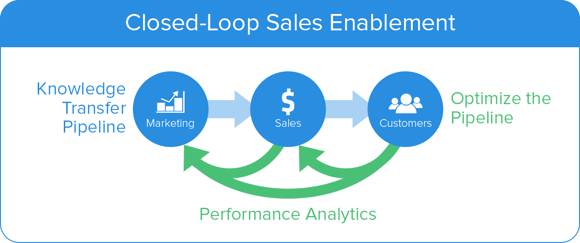 For anyone in sales or marketing, the relationship between the two teams can seem like a perfectly dysfunctional marriage. On one hand, salespeople and marketers rely on each other to do their best work and reach company goals. On the other, their independence can leave process and communication gaps that undermine their ability to achieve those mutual goals.
For anyone in sales or marketing, the relationship between the two teams can seem like a perfectly dysfunctional marriage. On one hand, salespeople and marketers rely on each other to do their best work and reach company goals. On the other, their independence can leave process and communication gaps that undermine their ability to achieve those mutual goals.
At the center of those process and communication gaps? Content.
While both salespeople and marketers want content that meets prospective customers’ and partners’ needs and ultimately drives ROI, they don’t always see eye to eye on how to accomplish that.
Sales claims that marketing’s involvement and interest evaporate once the lead is generated via content and delivered to the sales team. At the same time, marketing posits that sales doesn’t offer enough feedback on customer engagement to enable content creation or make it easier for sales to use content.
Avoiding the alignment problems won’t make them go away; in fact, that kind of “problem solving” puts everyone’s results at risk. It’s up to business leaders to address these differences and bridge the gap between these two teams before their companies can expect to move the needle. The solution isn’t a Band-Aid fix, either. Enabling marketing and sales is an ongoing strategic process, and it begins with these five steps:
Step 1: Select a diverse team.
Begin by dedicating an “alignment team” to the kickoff of this cross-department collaboration. Define ownership and accountability between sales and marketing, and assign roles to individuals to lead this effort.
Let marketing focus on developing content measured by engagement and revenue impact, and encourage sales to offer feedback on that content’s performance to drive your content marketing strategy forward. And ensure leaders of both teams understand the impact of your alignment strategy — and the costs of misalignment.
Step 2: Set ambitious goals.
Agree on a common strategy that sets both teams up for success, understanding the incentives at stake. Begin by laying out your goals and KPIs. Those goals could include earning a specific number of qualified leads from your blog content in one month or assessing how many closed deals your sales team wants to aim for each month.
It’s important to set aside time to meet regularly throughout the process. Get your sales and marketing teams in the same room for an effective meeting to discuss your progress or adjust your timeline. Between meetings, share cross-team metrics to stay up-to-date, and adjust your goal numbers if needed.
Confirm that the goals you’ve chosen are reachable yet challenging. This is your chance to put your content to the test and see what your alignment effort can really accomplish.
Step 3: Communicate regularly and consistently.
Establish regular communication between sales and marketing that documents your progress toward KPIs and provides qualitative feedback. Share metrics from both teams to gauge what content is performing well, how well customers are engaging with different pieces of content, and what new content might improve the process. Make your lives a little easier by exploring sales enablement tools that can do the heavy lifting for you.
Implementing these types of feedback loops between sales, marketing, and your customers is one of the most important steps to ensuring alignment between these two teams.
Step 4: Close content gaps.
With communication open, it’s time to find out what’s currently working and what’s not. Conduct a content audit that uncovers the usability and effectiveness of your team members’ contributions, and create a wish list outlining the content that would enhance their effectiveness.
Make sure you’re looking at how much a particular piece of content is utilized, and compare that to your original expectations. Is content being leveraged the way it was intended to be when it was made, or were your teams able to find new ways to maximize it? Might those new tactics affect how content is created in the future? Mapping actual results back to your original goals is crucial in determining the correct realignment of your content strategy.
Step 5: Implement a closed-loop improvement process.
This final step will ensure that your alignment efforts last long past the first few tries. Closing your team’s communication loop with modern sales enablement technology allows you to receive real-time reactions to content, harness customer insights, and use data to drive your most important business decisions.
Executing a process like the one illustrated below simply guarantees that your content will improve over time. With continuous feedback, you can get your content to work for you again — instead of working so hard for it yourself.

Alignment is more achievable today than ever before. Using these five steps, there’s no reason your sales and marketing teams can’t work hand in hand to achieve their common goals.
Learn more about bringing marketing and sales together by downloading your copy of "The Content Marketer's Guide to Sales Enablement" below:




 For anyone in sales or marketing, the relationship between the two teams can seem like
For anyone in sales or marketing, the relationship between the two teams can seem like 




